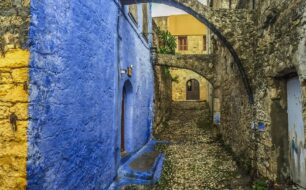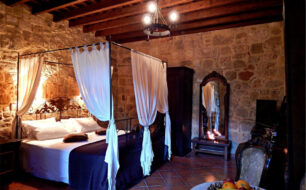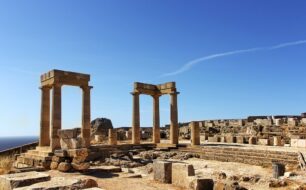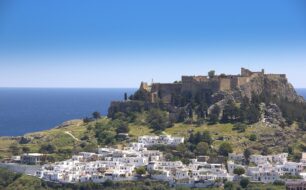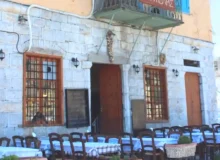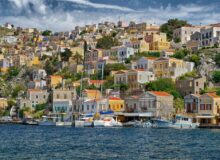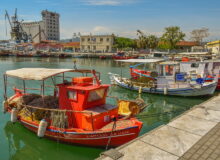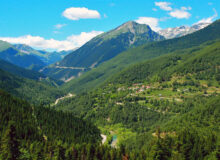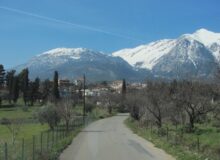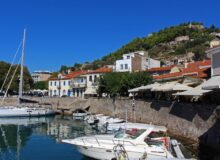The See Greece guide to the island of Rhodes with a brief history and travel information on how to get there by ferry or by air and what to see and do.

Introduction to Rhodes
Rhodes is the largest and most historically significant island in the Dodecanese, located in the southeastern Aegean Sea near the coast of Turkey. Known for its medieval Old Town, ancient ruins, and stunning beaches, Rhodes offers a perfect blend of history, culture, and natural beauty. Whether you’re interested in exploring ancient civilizations, relaxing on golden sands, or enjoying vibrant nightlife, this island has something for everyone.
This guide covers everything you need to know before visiting Rhodes, including its location, history, top attractions, the best time to visit, and how to get there by air and ferry.
Where is Rhodes Located?

Rhodes lies approximately 18 kilometers (11 miles) southwest of Turkey’s coast and about 430 kilometers (267 miles) southeast of Athens. It is the fourth-largest Greek island after Crete, Evia, and Lesvos. The island’s strategic position made it a crucial trading and military hub throughout history.
The capital, Rhodes Town, is at the northern tip of the island, while other key areas include Lindos, Faliraki, Ialysos, and Prasonisi. The island enjoys a Mediterranean climate, with hot summers and mild winters, making it a year-round destination.
A Brief History of Rhodes
Ancient Times
Rhodes has been inhabited since the Neolithic period, but its golden age began in 408 BC when the three ancient cities of Ialysos, Kamiros, and Lindos united to establish Rhodes Town. The island flourished as a major maritime and cultural center, producing famous works like the Colossus of Rhodes, one of the Seven Wonders of the Ancient World.
The Knights of St. John
In 1309, the Knights Hospitaller (Knights of St. John) conquered Rhodes and transformed it into a fortified stronghold. They built the Medieval Old Town, a UNESCO World Heritage Site, with its impressive walls, palaces, and cobbled streets. The knights defended Rhodes against invasions until 1522, when the Ottoman Empire seized control.
Ottoman Rule and Italian Occupation
Under Ottoman rule (1522–1912), Rhodes remained an important port. In 1912, Italy took over the Dodecanese islands, introducing infrastructure projects and restoring medieval buildings. After World War II, Rhodes officially became part of Greece in 1948.
Modern Times
Today, the island’s rich history is visible in its archaeological sites, medieval architecture, and diverse cultural influences.
What to See and Do on Rhodes
1. Explore Rhodes Old Town

A UNESCO-listed gem, the Medieval Old Town is one of the best-preserved medieval cities in Europe. Key highlights include:
– The Palace of the Grand Master – A 14th-century fortress with lavish interiors.
– Street of the Knights – A cobbled path lined with medieval inns.
– Archaeological Museum of Rhodes – Housed in the Hospital of the Knights, displaying ancient artifacts.
– Suleiman Mosque – A remnant of Ottoman rule.
2. Visit Lindos and the Acropolis

The picturesque village of Lindos is famous for its whitewashed houses and the Acropolis of Lindos, perched on a cliff overlooking the sea. The site includes a Doric temple of Athena Lindia and stunning panoramic views. See our full page all about Lindos.
3. Relax on Rhodes’ Best Beaches
– Faliraki Beach – A lively resort with golden sand and water sports.
– Tsambika Beach – A family-friendly beach with crystal-clear waters.
– Anthony Quinn Bay – A scenic cove with excellent snorkeling.
– Prasonisi Beach – A unique spot where the Aegean and Mediterranean seas meet, ideal for windsurfing.
4. Discover Ancient Kamiros
The ruins of Ancient Kamiros offer a glimpse into a Doric city abandoned in the 3rd century BC. The site includes residential areas, a temple complex, and an ancient water system.
5. Hike to Mount Filerimos
Near Ialysos, Mount Filerimos features a monastery, a cross-shaped pathway with panoramic views, and remnants of an ancient acropolis.
6. Experience Local Villages
– Embonas – A traditional mountain village known for its wineries.
– Archangelos – Famous for handmade ceramics and folk traditions.
– Siana – A charming village producing honey and souma (local spirit).
7. Enjoy Nightlife in Rhodes Town and Faliraki
– Rhodes Town offers elegant bars and tavernas in the Old Town.
– Faliraki is the island’s party hub, with beach clubs and late-night entertainment.
8. Take a Boat Trip to Symi or Chalki

From Rhodes, you can take a day cruise to the nearby islands of Symi (colorful neoclassical houses) or Chalki (a tranquil escape with pristine beaches).
Best Time to Visit Rhodes
Peak Season (June–August)
– Weather: Hot and sunny (25°C–35°C / 77°F–95°F).
– Pros: Ideal for beach lovers, vibrant nightlife, and festivals.
– Cons: Crowded, higher prices.
Shoulder Seasons (April–May & September–October)
– Weather: Warm but comfortable (20°C–28°C / 68°F–82°F).
– Pros: Fewer crowds, pleasant weather for sightseeing.
– Cons: Some beach bars may close in late October.
Off-Season (November–March)
– Weather: Mild (12°C–18°C / 54°F–64°F), occasional rain.
– Pros: Quiet, lower prices, great for cultural exploration.
– Cons: Limited ferry schedules, some attractions closed.
Best for sightseeing: April–June & September–October.
Best for beach holidays: June–September.

How to Get to Rhodes
By Air
Rhodes has an international airport (Diagoras Airport, RHO), located 14 km southwest of Rhodes Town.
– Direct flights from major European cities (London, Berlin, Paris, Amsterdam).
– Domestic flights from Athens (50 min), Thessaloniki, and Crete.
– Airline options: Aegean Airlines, Ryanair, EasyJet, Jet2, and others.
By Ferry
Rhodes is well-connected to other Greek islands and mainland ports.
– From Athens (Piraeus): 12–18 hours (conventional or high-speed ferries).
– From other Dodecanese islands: Symi, Kos, Karpathos, and Leros (1–4 hours).
– From Turkey: Daily ferries from Marmaris (1 hour).
Major ferry companies: Blue Star Ferries, Dodekanisos Seaways, ANEK Lines.

Final Tips for Visiting Rhodes
– Rent a car or ATV to explore remote beaches and villages.
– Wear comfortable shoes for walking on cobbled streets in the Old Town.
– Try local dishes like pitaroudia (chickpea fritters) and melekouni (honey sesame bars).
– Respect archaeological sites – some areas prohibit climbing on ruins.



